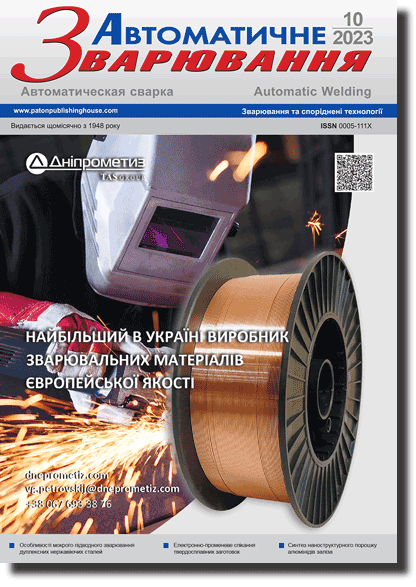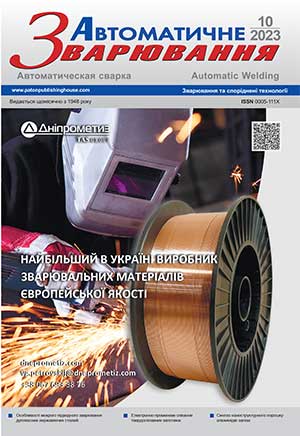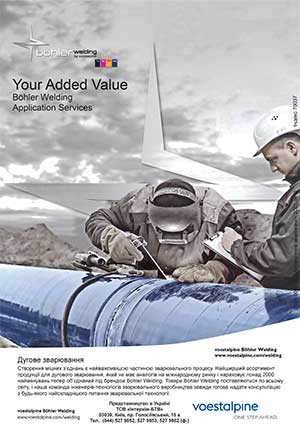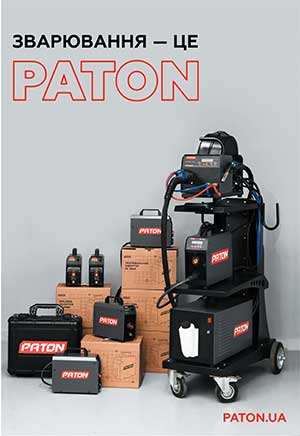| 2023 №10 (06) |
DOI of Article 10.37434/as2023.10.07 |
2023 №10 (08) |
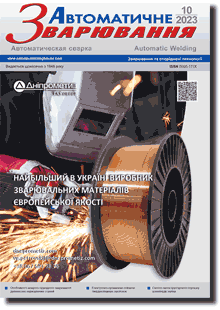
"Avtomatychne Zvaryuvannya" (Automatic Welding), #10, 2023, pp. 53-59
Influence of thermal contacts on heating aluminium plates under non-stationary heating conditions, using the SHS-process
A.I. Ustinov, M.V. Kulinich, S.G. Kosintsev
E.O. Paton Electric Welding Institute of the NAS of Ukraine. 11 Kazymyr Malevych Str., 03150, Kyiv, Ukraine. E-mail: office@paton.kiev.uaThe temperature of the heater, which can be used to join a plate of limited dimensions, to a shell of unlimited dimensions by brazing, in the general case is determined by melting temperature of the filler metal and characteristics of heat transfer in the plate contact zone. In the case of a low heat transfer in the contact zone, its heating to the temperature required for brazing is complicated, as a result of spreading of the heat coming into the shell. The work is an experimental study of the impact of nonideal thermal contacts between the aluminium plates on their heating, using a flat heater, which is in contact with one of the plates. It turned out that the force of pressing the contacting plates to each other has a greater effect on heat transfer in the contact zone that the surface roughness. Here, the value of the coefficient of effective heat transfer changes jumplike during heating of the plates, which is associated with microplastic deformation of their surface layers under the impact of a compressive load. A computational-experimental method of self-consistent determination of the values of the coefficient of effective heat transfer for different temperatures was proposed, which is based on comparison of experimentally measured and calculated thermograms of plate heating. 11 Ref., 6 Fig.
Keywords: temperature fields, nonstationary heating process, thermal contacts, brazing, multilayer foils
Received: 25.07.2023
References
1. Kulinich, M.V., Zaporozhets, T.V., Gusak, A.M., Ustinov, A.I. (2019) Calculation of thermal fields during joining aluminium plates through interlayers at local heating of the joint zone. The Paton Welding J., 4, 11-18. https://doi.org/10.15407/tpwj2019.04.032. Vasenin, Yu.L., Zagrebelny, A.A., Zelnichenko, A.Y. et al. (2001) Modelling of thermal process in piping repair in space. The Paton Welding J., 4, 18-23.
3. Krivtsun, I.V., Kvasnytskyi, V.V., Maksymov, S.Yu., Iermolaev, G.V. (2017) Special methods of welding: Manual. Ed. by B.E. Paton. Mykolaiv, NUK [in Ukrainian].
4. Weihs, T., Barmak, K., Coffey, K. (2014) Fabrication and characterization of reactive multilayer films and foils. Metallic films for electronic, optical and magnetic applications: Structure, Processing and Properties, 40, 160-243. https://doi.org/10.1533/9780857096296.1.160
5. Popov, V.M. (1971) Heat exchange in the zone of detachable and permanent joints. Moscow, Energiya [in Russian].
6. Lykov, A.V. (1978) Reference book on heat-, mass exchange. Moscow, Energiya [in Russian].
7. Bezpalchuk, V.M., Zaporozhets, T.V., Kravchuk,, M.V. et al. (2015) Calculation of thermal fields in multiphase 3D system under nonstationary conditions of its heating. Visnyk Cherkaskogo Un-tu, 16 (349), 38-49 [in Ukrainian].
8. Kulinich, M.V., Bezpalchuk, V.N., Kosintsev, S.G. et al. (2018) Calculation-experimental investigation of thermal fields in the process of nonstationary soldering. The Paton Welding J., 1, 14-19. https://doi.org/10.15407/tpwj2018.01.03
9. Summers, P.T., Chen, Y., Rippe, C.M. et al. (2015) Overview of aluminum alloy mechanical properties during and after fires. Fire Science Reviews, 4 (1), 1-36. https://doi.org/10.1186/s40038-015-0007-5
10. Su, M.-N., Young, B. (2017) Mechanical properties of high strength aluminium alloy at elevated temperatures. Ce/ papers, 2-3 (1), 2831-2839. https://doi.org/10.1002/cepa.334
11. Ustinov, A.I., Melnychenko, T.V., Demchenkov, S.A. (2021) Structural mechanism of plastic deformation of Al/а-Si multilayer foils at heating under load. Materials Science & Engineering AA 810, 141030. https://doi.org/10.1016/j.msea.2021.141030
Advertising in this issue:
The cost of subscription/purchase order journals or individual articles
| Journal/Currency | Annual Set | 1 issue printed |
1 issue |
one article |
| TPWJ/USD | 384 $ | 32 $ | 26 $ | 13 $ |
| TPWJ/EUR | 348 € | 29 € | 24 € | 12 € |
| TPWJ/UAH | 7200 UAH | 600 UAH | 600 UAH | 280 UAH |
| AS/UAH | 1800 UAH | 300 UAH | 300 UAH | 150 UAH |
| AS/USD | 192 $ | 32 $ | 26 $ | 13 $ |
| AS/EUR | 180 € | 30 € | 25 € | 12 € |
| SEM/UAH | 1200 UAH | 300 UAH | 300 UAH | 150 UAH |
| SEM/USD | 128 $ | 32 $ | 26 $ | 13 $ |
| SEM/EUR | 120 € | 30 € | 25 € | 12 € |
| TDNK/UAH | 1200 UAH | 300 UAH | 300 UAH | 150 UAH |
| TDNK/USD | 128 $ | 32 $ | 26 $ | 13 $ |
| TDNK/EUR | 120 € | 30 € | 25 € | 15 € |
AS = «Automatic Welding» - 6 issues per year;
TPWJ = «PATON WELDING JOURNAL» - 12 issues per year;
SEM = «Electrometallurgy Today» - 4 issues per year;
TDNK = «Technical Diagnostics and Non-Destructive Testing» - 4 issues per year.





